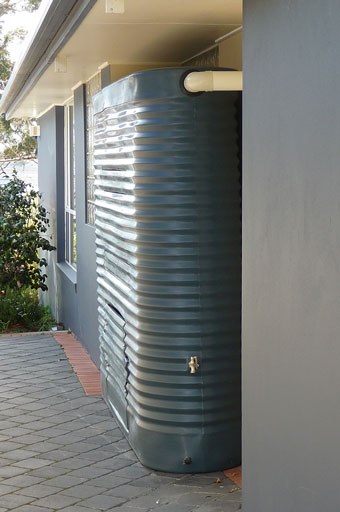07 February 2020
I'm building a new house, do I need a rainwater tank?
If you're planning to build a new house, one of the things to consider is whether you will need a rainwater tank. And if you do, there are a number of things you'll need to consider.

he main reason you would need a rainwater tank is if you are not on the mains water supply. You may also want a rainwater tank to collect pure rainwater to use in the garden. Collecting rainwater a great way to cut down on your reliance on the mains water supply and reduce your usage of potable mains water.
What shape rainwater tank should I get?
There are two basic rainwater tank shapes, and which one is better suited to your needs depends on where you want to place your tank. Slimline water tanks are great if you want your tank to be hidden away. They can sit up against the wall of your house and keep a low profile. You can even plant bushes in front of them to make them more inconspicuous.
Round rainwater tanks have a larger capacity so if you need to store a large volume of water, a round rainwater tank is your best bet.
Where should I put my rainwater tank?
Most people don't want their rainwater tank in plain view, so around the back or at the side of the house will keep it out of the way. If you are planning to use water from the tank in the garden, then having it near the garden is also a good idea.
When working out where you are going to place your rainwater tank, you should consider where your downpipes are located. If you are building, you have the capacity to plan where your downpipes are positioned in relation to your rainwater tank so as to optimise grey water collection.

Council Regulations
Before installing a rainwater tank, you'll need to check the council regulations for your area. All tanks need to be installed by a licenced plumber, you'll most likely need to get planning permission and, for above ground tanks, you may even need to lodge a heritage application.
Here are a few links to the relevant council regulations:
Hobart City Council
Launceston City Council
Department of Health
What size rainwater tank will I need?
The size of the rainwater tank you need depends on the amount of water you will need and the average rainfall in your area. We've prepared a handy tool to give you a good estimation on how much water you'll be able to collect based on the size of your roof and the average rainfall in your area.
What colour rainwater tank should you choose?
The colour of the rainwater tank depends on whether you want it to stand out or blend in. If you want it to blend in, what do you want it to blend with? If it's going to be next to your wall, you might want it to blend in with brick or render. Or if it's out in the garden, you might want it to blend with your natives.
Whatever colour you want to match your rainwater tank with, we've got you covered. Orion rainwater tanks come in a range of colours colour-matched to the COLORBOND range.
What materials are you going to use for your rainwater tank?
Rainwater tanks come in a wide range of materials to suit all manner of water storage solutions, the main materials nowadays being polymer (poly for short) or steel. While they all have their strengths and weaknesses in terms of durability, resistance to corrosion, ease of installation etc., we think poly rainwater tanks are the standout winner they don't rust or corrode, they are light, making them easy and cost effective to install and they are super durable.
For a more detailed comparison of polymer and concrete rainwater tanks, see our article on the topic.
If you're planning to build and would like to find the best rainwater tank for you, contact our friendly staff today.


